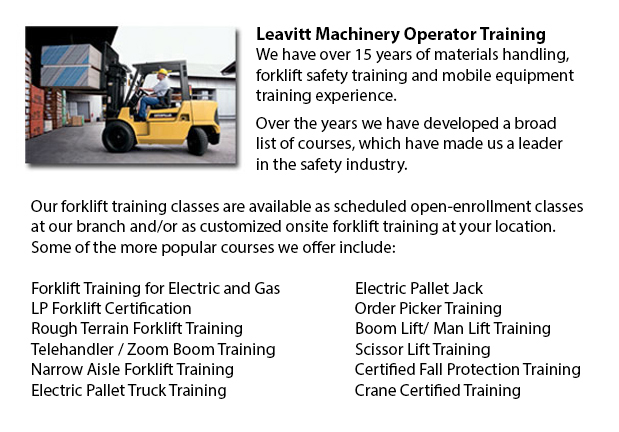
Pallet Stackers Training Barrie - Pallet stackers are a style of pallet jack that can be employed to stack, transport and haul cargo positioned on a pallet that are far too burdensome for manual lifting. Mostly these mechanisms are used to load and unload supplies from trucks and to move pallets from one location to another within a warehouse of storeroom space. For the most part pallet jacks are built of heavy duty materials to withstand tremendous weights. Pallet stackers are occasionally called pallet jacks. They can be operated from a seated, upright or walk-behind position. Pallet stackers are separated into manual and powered styles.
Pallet stackers are commonly comprised of a pair of forks that are capable of sliding beneath a pallet, capable of raising to a desired height or transporting it to a specific location. The motor section or casing houses the gas-run, electronic or hydraulic equipment that powers the machine.
Commonly, pallet stackers come in walk-behind versions that are hand-powered. This means that they are moved by pushing and pulling the jack into its desired location, while raising the heavy pallets will be operated hydraulically making this job a great deal easier. Using a foot pedal or handle raises the stacker's forks. Squeezing a handle or trigger returns the forks to the ground. These models of pallet jacks are ideal for lighter loads of up to approximately 1 ton or 907.18 kg.
Electric or gas driven pallet stackers can accommodate heavy lifting weights of up to 5 tons or 4535.92 kg. They are physically less demanding than the manual designs due to the mechanized power to raise and let down the stacker's forks. These versions are steered by turning the handle in a specific direction. There is a button on the handle that functions to raise and lower the forks. A throttle set up on the stacker's handle moves the machine forward and in reverse. This style of equipment is regularly known as a forklift and is used from a sit-down position.
As the fork width, weight maximum and lift peak differ dramatically between specific designs, choosing the right pallet stacker to suit the job is important. Some stacker's lift peak may permit multiple pallets to be stacked, while others may only permit two at a time. Certain models of these lift trucks include an modifiable fork in order to allow the stacker to slide beneath pallets of atypical sizes and shapes. Numerous fork models can be quite effective when different varieties of pallets are being utilized in the same stockroom.
-
Boom Trucks
Boom Trucks Training Barrie - Boom vehicle are often applied by phone, cable television and utilities organizations as they have extended folded arms which are commonly folded over the roofs of business vehicles. On the end of the extension of extend... More -
Reach Trucks
Reach Truck Training Barrie - Reach trucks are loading machines used by varieties of organizations that keep up a stockroom facility or circulation center relating to the arrangement of completed commodities and equipment on pallets which are inserte... More -
Genie Forklift
Genie Forklift Training Barrie - Genie is a globally established company that enjoys the spirit of collaboration with their extensive network of allied consumers. Genie Industries prides itself on the intention of bringing materials and people higher... More -
Toyota Forklift
Toyota Forklift Training Barrie - Since 1992, Toyota Material Handling inc., U.S.A., often known as TMHU, has been the best selling lift truck supplier in the United States. Proudly celebrating more than 40 years of service, the Irvine, California si... More -
Scissor Pallet Trucks
Scissor Pallet Truck Training Barrie - Scissor pallet trucks are built for transporting and lifting singly stacked pallets by integrating a raising apparatus that permits the pallets on the vehicle to be elevated. This equipment is a great device for... More

Forklift Certification Barrie
TOLL FREE: 1-888-254-6157
Barrie, Ontario
forkliftcertificationbarrie.com
Email Us
About Us


